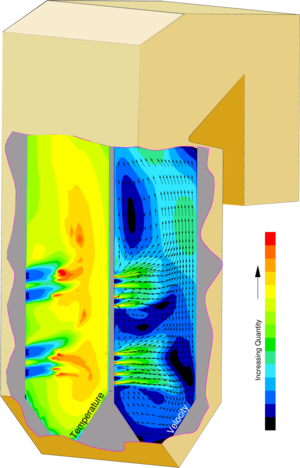VISCOUS
VISCOUS is one of our in-house codes and has been used since 1985 for a wide range of industrial flow problems.
The code is fully three dimensional and is used in the following: 
- Complex subsonic flow fields - Newtonian or non-Newtonian*, laminar or turbulent. Turbulent flow fields use the well known k-epsilon turbulence model to account for small scale eddy structures even in relatively coarse grids.
- Conjugate heat transfer problems.
- Homogeneous, two-phase flows.
- Body forces including gravitational, rotational, or electro-magnetic* may be present.
- Internal heat sources may be present.
- Mass sources and sinks may be specified.
- Material properties such as density, viscosity, and conductivity may depend on position, temperature, concentration, and other properties.
- Chemical species may react.*
- Boundary conditions may be of the known value or known flux variety.
- Distributed pressure resistances (screens/porous grids) may be modeled.
- Heater cores and/or evaporator coils may be modeled, correctly accounting for the dependence of heat transfer on air velocity, fin temperature, fin spacing and fin geometry.
- Time dependent flow fields may be computed using constant or varying boundary conditions.
*These items require a non-standard version of VISCOUS.
